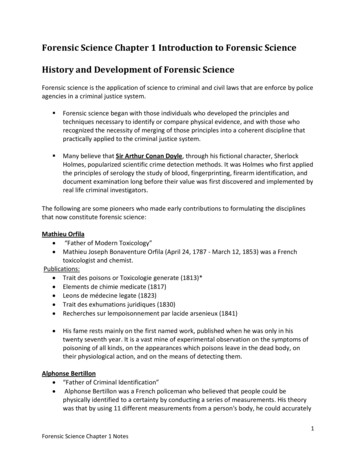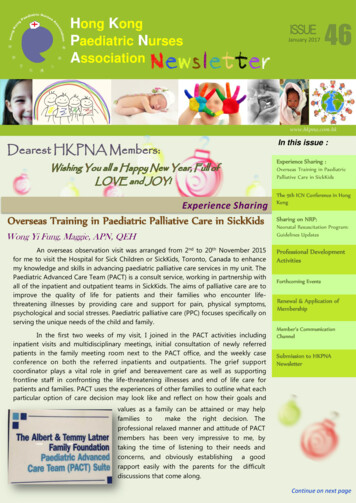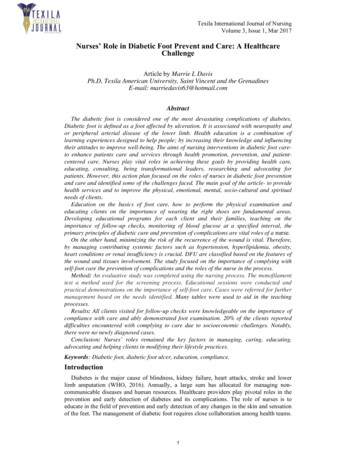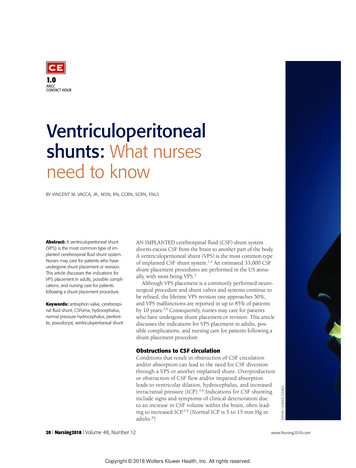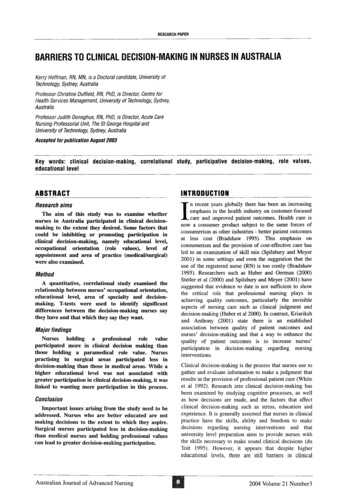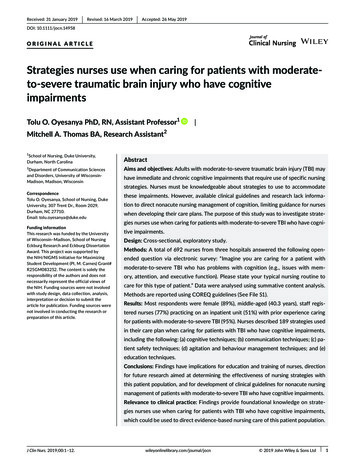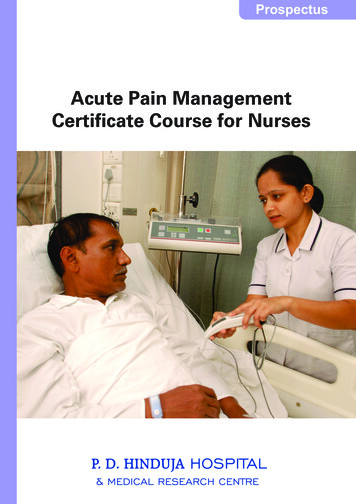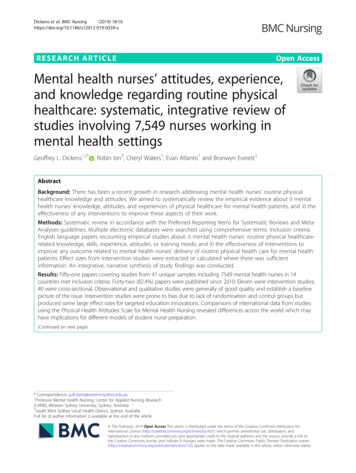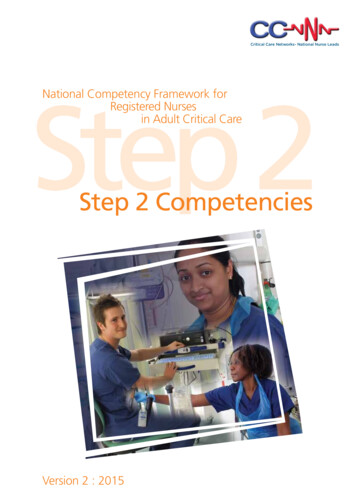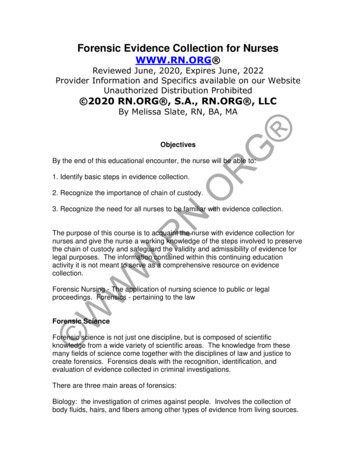
Transcription
Forensic Evidence Collection for NursesWWW.RN.ORG Reviewed June, 2020, Expires June, 2022Provider Information and Specifics available on our WebsiteUnauthorized Distribution Prohibited 2020 RN.ORG , S.A., RN.ORG , LLCBy Melissa Slate, RN, BA, MAObjectivesBy the end of this educational encounter, the nurse will be able to:1. Identify basic steps in evidence collection.2. Recognize the importance of chain of custody.3. Recognize the need for all nurses to be familiar with evidence collection.The purpose of this course is to acquaint the nurse with evidence collection fornurses and give the nurse a working knowledge of the steps involved to preservethe chain of custody and safeguard the validity and admissibility of evidence forlegal purposes. The information contained within this continuing educationactivity it is not meant to serve as a comprehensive resource on evidencecollection.Forensic Nursing - The application of nursing science to public or legalproceedings. Forensics - pertaining to the lawForensic ScienceForensic science is not just one discipline, but is composed of scientificknowledge from a wide variety of scientific areas. The knowledge from thesemany fields of science come together with the disciplines of law and justice tocreate forensics. Forensics deals with the recognition, identification, andevaluation of evidence collected in criminal investigations.There are three main areas of forensics:Biology: the investigation of crimes against people. Involves the collection ofbody fluids, hairs, and fibers among other types of evidence from living sources.
Drugs and Toxicology: involves criminal and non-criminal deaths as well ascrimes associated with the use of drugs such as drunken driving, overdose, orcrimes committed while intoxicated.Chemistry: involves the identification and analysis of paint chips, drugs, glass, orother chemical compounds to determine their composition and origin.Forensic NursingForensic nursing skills are needed by nurses in every healthcare setting; theneed for forensics in nursing is not limited to just nurses who choose tospecialize in this field of medicine. Every patient may be a forensic nursing casebefore you are able to assess them and determine their medical problems andnursing care needs. In the ER, you may encounter rape victims, child abuse andelder abuse as well as domestic violence cases. There may be hit and runaccidents or gunshot wounds. Victims of hit and run accidents and gunshotwounds are likely to make it into an OR where you might be working, or senthome with complex dressings that you will need to teach and monitor as a homehealth nurse. In all these scenarios, your evidence collection (and think about it,your assessment alone can be evidence) can make or break a case for a patientwho has been the victim of a crime; or worse yet committed the crime.The forensic skills that are required by all nurses are basic principles of evidencecollection, chain of custody, and documentation of forensic findings (Stowkowski,2008). Collecting and preserving evidence is a nurses legal, ethical, andprofessional responsibility. Some facilities have the luxury of having aspecialized forensics nurse on staff, but this is not the norm; usually thisresponsibility falls to the nurse caring for the patient.When staff lack proper education, these duties may be perceived by the nurse asa burden, and vital evidence that could make or break a case for a patient maybe lost as a result. There are two standards of care established by the JointCommission that require nurses to identify abuse and neglect and assesspatients within the context of the requirements. This standard makes itmandatory for all nurses to preserve evidence and support future legal actions inthe cases of physical assault, rape, sexual molestation, domestic abuse, childabuse, or neglect, and elder abuse or neglect. All nurses must know how andwhen to make appropriate referrals for the care of such victims.Nurses are often the first health care professional to see patients who are victimsof crime or accidents. The procedures involved in collecting of forensic evidencecan add to the trauma already experienced by patient. A nurse who is sensitiveto the emotional state of the victim can gain the trust of the patient and preservesensitive evidence that otherwise might be lost.
Forensic nursing has evolved as it was realized that evidence could be destroyedin caring for patients when accident or crime victims were brought into theemergency room. Before the awareness of the need to preserve legal evidence,nurses often inadvertently destroyed evidence by using shears to cut away apatient’s clothing, often starting at the entrance of a bullet wound or stab onewound. Evidence collection bags were not yet a part of trauma room supplies.Cleaning of patients to remove blood and assess wounds often destroyedvaluable evidence.Within the last fifteen years, the role of forensic evidence in the courts has beenelevated. Nurses are increasingly developing professional relationships withpolice to assist in the preservation and collection of evidence. This places agreater demand upon nurses to be familiar with the rights of both victims andsuspects, and to be cognizant of local state and Federal laws pertaining to thereporting of crimes and the collection of evidence.Prioritizing care remains a nursing responsibility; lifesaving intervention shouldnot be delayed in order to collect forensic evidence. However, the nurse must beable to recognize and not destroy what may be the evidence of a crime. Thenurse is also responsible for maintaining the chain of custody for evidencecollected. Every trauma patient should be considered a forensic patient untilproven otherwise.Forensic evidence collection is a systematic process that follows state andFederal guidelines. The references pertaining to evidence collection should bereadily available in every setting. Most evidence collection kits will containinstructions for using the items contained within them.Before beginning the evidence collection procedure, informed consent fromadults should be obtained. The consent should advise the patient what evidencewill be collected including photography if planned and who the recipient of theevidence will be. The content of the consent form should also addressconfidentiality issues.HistoryThe evidence collection process begins with taking a thorough history. Thisallows for the formulation of a diagnosis and treatment plan and to provide aprocedure to determine the type of evidence that needs to be collected. Theinterview should begin by taking a thorough history of how the injuries weresustained and relevant medical conditions that the patient may have. Knowledgeof the details surrounding the crime such as where on the body the victim was hitor the use of restraints will direct examination and assist in the retrieval ofevidence.
The medical record is a tool that may result in the conviction of an assailant if thecase ever goes to court. Clearly document all findings, interventions, and actionsin a legible manner.Record what the patient says verbatim enclosing in quotation marks as needed.Record a description of the incident as the patient relates it, and history orincidents of prior abuse if applicable.The nurse should document statements exactly as they are made without bias,alteration, or interpretation. In order to obtain the most information, open-endedquestions should be used.If the patient is reluctant to speak frankly or it seems they are not telling all thetruth document the patient behavior using objective language.Include other areas of physical or mental concern that may relate to the abuse.Include the name and as much demographic information as possible about theabuser and their relationship to the victim.PhotographyDocument injuries as completely and thoroughly as possible noting location, size,shape, color, and apparent age. Also, include anatomical charts and colorphotographs of the injuries before treatment.If photographs are taken, attach a consent form to the chart and use a Polaroidor digital camera to take the images. One photograph should be a full body shotthat includes the victim’s face. This clearly links the injuries to the victim. Includea torso image and close-ups of all bruises and wounds. Include two shots ofeach injury taken from two different angles with a reference device such as aruler in the picture to indicate size of the wounds.On the back of the photograph write the patient name, medical record number,date and time of the photograph, name of the photographer, location, and namesand titles of witnesses. The photographer should sign the photograph.One the back of the photograph indicate the location of the injury and thesubjects stated cause of injury. Torn and damaged clothing also may bephotographed. Document injuries not clearly indicated by photographs on a bodychart. Preserve any damaged clothing, jewelry, or weapons using the chain ofevidence protocol.If the patient has been sexually assaulted, take care to preserve any evidenceand follow protocols for examination and collection of specimens (Burnett, 2006).When feasible, photographs should be taken before wounds are treated.Photographs should never be used as a substitute for accurate and thoroughmedical documentation. If the patient has been sexually assaulted, and haswounds to the genital area, careful draping of the patient and close up
photography of the injuries can preserve patient dignity. Be certain to documentthe patient’s name and the exact location of the injury on the photograph.Describing and DiagrammingA written description of assessment findings including details about the patientinjuries must be made according to an institutional policy. Precision is importantwounds should be measured in centimeters and described according to size,shape, appearance, and location using a readily recognized landmarks. Signs ofabuse or neglect can be subtle and may not be immediately recognized. Forelderly patients, fractures, abrasions, decubitus ulcers, or dehydration should bedocumented because these can be signs of abuse or neglect.The descriptions of wounds should be made using medical terminology andshould be specific and accurate. A laceration is a tear of the skin or tissue thatoccurs when external blunt force is applied. A laceration has marginal abrasionand the tissue bridging, where as a cut severs the tissues cleanly and there is nobridging. The nurse should not attempt to determine the age of the wound onebased on the color of bruising present. Also, if bullet wounds are present do notattempt to differentiate between the entrance and exit wounds.A body charts should be used to describe the exact location of a person’sinjuries. Diagrams are visual supplements to written assessment findings.Drawings are also important to show the relationship of injuries one to anotherand provide a pattern of wounds present.Documentation that best supports forensic evidence will reflect:Objective and detailed information.Direct quotes using quotation marks as often as possible (even if a patient usesvulgar terms or slang words that describe the event).Avoiding paraphrasing, as it will detract from the patient’s credibility. Using thepatients own words without medical terminology or grammatical corrections willhelp to establish the patient’s history.Avoiding pejorative documentation such as the word alleged; alleged can implythe possibility that the patient’s statements might not be true (use direct quoteswhenever possible).Remember that documentation is an important part of the chain of evidence andshould include:Site and time of assault.Nature of physical contacts.
Race and number of assailants.Relationship to assailant(s).Weapons and restraints used.Actual and attempted penetration of which orifice by penis, objects or fingers.Ejaculation, if known, and where.Use of condom.Activities of the victim that may have destroyed evidence, such as bathing,douching,bowel movement.Consenting sex within the last 72 hours and with whom.Use of tampon.Change of clothes.Contraceptive use.Current pregnancy.Allergies.Victim’s general appearance and response during exam.Physical injuries.Collecting Physical EvidenceDr. Edmond Locard developed a theory of evidence called Locard’s principle ofexchange. This theory states that criminals leave marks of their passage whileon the other hand at the same time by inverse action take with them on theirbody or clothing evidence of his deed. Whenever there is contact between twoobjects mutual exchange of material occurs Physical evidence is defined as anyobject or part of an object showing that a crime has occurred or establishing arelationship between a victim and a perpetrator. Physical evidence can betangible or transient such as redness or trace body fluids.
Clothing, footwear, hairs, fibers, stains, bullets, sharp objects, physical injuries,and laboratory specimens are all classified as physical evidence. Gloves arealways worn during the handling of all physical evidence. Gloves should bechanged often during evidence collection.Label all packages used to collect evidence with the date, time, patient’s namedescription, and source of the material including the body location. Also, includethe name of the healthcare provider, and names with initials of everyone whohandled the material.Collecting Forensic Evidence from ClothingThe clothing must be removed carefully because it can contain hair, fibers, orother trace evidence. If the patient is ambulatory, they should remove one itemof clothing at a time while standing over a clean sheet or piece of paper placedon the floor. This sheet should be covered with a second clean sheet or piece ofpaper to capture evidence that may fall from the clothing of the person. This topsheet is folded and packaged separately.If clothing must be cut off, out cutting through any tears, holes, or defects in thefabric.A
Forensic nursing skills are needed by nurses in every healthcare setting; the need for forensics in nursing is not limited to just nurses who choose to specialize in this field of medicine. Every patient may be a forensic nursing case before you are able to assess them and determine their medical problems and nursing care needs. In the ER, you may encounter rape victims, child abuse and elder .
